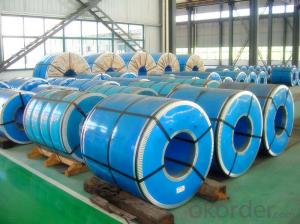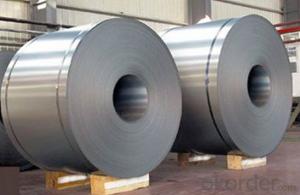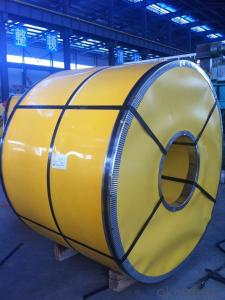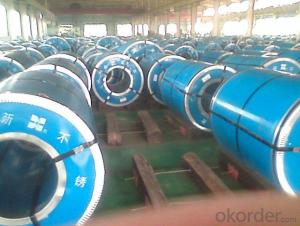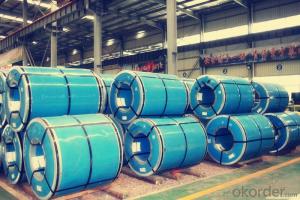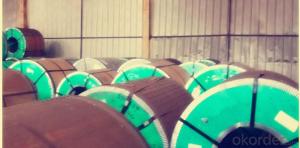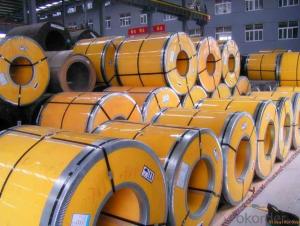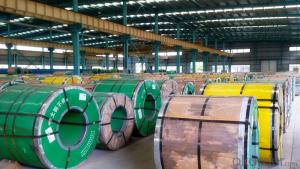Stainless Steel Coil/Sheet 304 NO.1 HRAP
- Loading Port:
- Ningbo
- Payment Terms:
- TT OR LC
- Min Order Qty:
- 100 m.t.
- Supply Capability:
- 20000 m.t./month
OKorder Service Pledge
Quality Product, Order Online Tracking, Timely Delivery
OKorder Financial Service
Credit Rating, Credit Services, Credit Purchasing
You Might Also Like
Chemical composition: | |||||||
C | Si | Mn | Cr | Ni | S | P | |
≤0.07 | ≤1.0 | ≤2.0 | 18.0~20.0 | 8.0~11.0 | ≤0.03 | ≤0.035 | |
mechanical properties: | |||||||
Tensile strength σb (MPa) | Conditions yield strength 0.2 sigma (MPa) | Elongation δ5 (%) | Section shrinkage (%) | Hardness | |||
520 | 205 | 40 | 60 | ≤1 | |||
- Q: Can stainless steel strips be used in chemical storage applications?
- Yes, stainless steel strips can be used in chemical storage applications. Stainless steel is highly resistant to corrosion and can withstand exposure to various chemicals, making it an excellent choice for storing chemicals safely. Additionally, stainless steel is durable, easy to clean, and has a high strength-to-weight ratio, making it suitable for storing and transporting chemicals in different environments. Its non-reactive nature ensures that the stored chemicals remain uncontaminated, and stainless steel's ability to withstand high temperatures further enhances its suitability for chemical storage applications.
- Q: Can stainless steel strips be used in chemical pumps?
- Indeed, chemical pumps can employ stainless steel strips for their operation. Stainless steel boasts remarkable resistance against corrosion and can endure exposure to a diverse array of chemicals. It finds widespread application in the fabrication of chemical pumps and other apparatuses that encounter corrosive substances. By utilizing stainless steel strips, the pump's robustness and longevity are secured, rendering it apt for handling a multitude of chemical variants.
- Q: What is the maximum length available for stainless steel strips?
- The maximum length of stainless steel strips may differ depending on the manufacturer and the specific requirements of the customer. Typically, stainless steel strips can be manufactured in lengths ranging from a few inches to several feet. Certain manufacturers might have the ability to produce even lengthier strips, depending on their capabilities and equipment. To ascertain the maximum length available for stainless steel strips that align with your specific needs, it is crucial to consult with the manufacturer or supplier.
- Q: Stainless steel narrow band, what are the spare rolls and side bands?
- Narrowband: General slitting machine, can only be divided into 12 ~ 15 mm width, and then down, it is not accurate, and therefore narrower band, you must use a special separator, so the price of narrowband will be higher.
- Q: How do stainless steel strips resist stress corrosion cracking in sulfuric acid?
- Stainless steel strips resist stress corrosion cracking in sulfuric acid due to their high chromium content, which forms a protective passive oxide layer on the surface. This oxide layer acts as a barrier, preventing the corrosive sulfuric acid from coming into direct contact with the underlying metal, thereby reducing the risk of stress corrosion cracking.
- Q: Can stainless steel strips be used in the production of automotive parts?
- Stainless steel strips possess the capability to be utilized in the manufacturing of automotive components. Stainless steel, being an incredibly versatile material, offers remarkable strength, durability, and resistance against corrosion, rendering it suitable for a diverse range of automotive applications. The utilization of stainless steel strips enables the production of a wide array of automotive parts, encompassing body panels, trim, exhaust systems, brackets, and reinforcements. The remarkable strength-to-weight ratio of stainless steel facilitates the creation of lightweight automotive components without compromising their strength and performance. Furthermore, the resistance of stainless steel to rust and corrosion guarantees that automotive parts crafted from this material exhibit exceptional durability and can endure harsh environmental conditions, such as exposure to moisture, road salt, and chemicals.
- Q: What are the different types of stainless steel strip alloys?
- Stainless steel strip alloys are classified according to their chemical composition and properties, which determine their suitability for different uses. Here are several types of stainless steel strip alloys: 1. Austenitic stainless steel: This is the most commonly used stainless steel strip alloy due to its outstanding resistance to corrosion. It contains high amounts of chromium and nickel, providing stability and durability. Austenitic stainless steel is not magnetic and is frequently employed in industries like food processing, chemicals, and pharmaceuticals. 2. Ferritic stainless steel: Ferritic stainless steel strip alloys have a higher chromium content compared to other alloys. They are magnetic and exhibit good resistance to corrosion, heat, and stress. These alloys are commonly utilized in applications requiring high strength and resistance to oxidation, such as automotive exhaust systems and household appliances. 3. Martensitic stainless steel: Martensitic stainless steel strip alloys are hard and strong, making them suitable for applications that demand wear resistance and high mechanical properties. They have a higher carbon content, allowing them to be hardened through heat treatment. These alloys are frequently used in cutlery, surgical instruments, and turbine blades. 4. Duplex stainless steel: Duplex stainless steel strip alloys have a mixed microstructure of austenite and ferrite, offering a balanced combination of strength and corrosion resistance. They contain higher levels of chromium and molybdenum, making them highly resistant to stress corrosion cracking and pitting. Duplex stainless steel is commonly employed in chemical processing, oil and gas, and marine environments. 5. Precipitation-hardening stainless steel: These alloys can be heat treated to achieve high strength and hardness. They contain elements like nickel, copper, and aluminum, which form precipitates during the heat treatment process, resulting in increased strength. Precipitation-hardening stainless steel is frequently used in aerospace applications, as well as high-performance automotive components. It is important to note that each type of stainless steel strip alloy has numerous grades and variations available, each with its own specific properties and applications. Therefore, it is crucial to carefully select the appropriate alloy based on the requirements of the intended application.
- Q: What are the physical properties of stainless steel strips?
- Stainless steel strips have several distinct physical properties that make them a popular choice in various industries. Firstly, stainless steel strips are known for their high strength and durability. This material possesses excellent tensile strength, allowing it to withstand heavy loads and resist deformation or breakage. Another important physical property of stainless steel strips is their corrosion resistance. This material is specifically designed to resist oxidation and corrosion, making it ideal for applications that involve exposure to moisture, chemicals, or harsh environments. Stainless steel strips can maintain their integrity and appearance even in corrosive conditions, minimizing the need for frequent maintenance or replacement. Stainless steel strips also exhibit a high melting point, which contributes to their overall strength and heat resistance. This property makes stainless steel strips suitable for applications that involve high temperatures, such as in the automotive, aerospace, or manufacturing industries. Additionally, stainless steel strips are known for their excellent conductivity. This material can efficiently conduct heat and electricity, making it suitable for applications that require efficient heat transfer or electrical conduction, such as in the construction of appliances, electrical enclosures, or heat exchangers. Moreover, stainless steel strips have a visually appealing appearance due to their smooth and lustrous surface. This property makes them popular in architectural and decorative applications where aesthetics are important. In summary, the physical properties of stainless steel strips include high strength, corrosion resistance, high melting point, excellent conductivity, and visually appealing appearance. These properties make stainless steel strips versatile and widely used in various industries, including construction, automotive, aerospace, and manufacturing.
- Q: How do you select the right grade of stainless steel strip for a specific application?
- Selecting the right grade of stainless steel strip for a specific application requires careful consideration of various factors. Here are the steps to follow in order to make an informed decision: 1. Identify the application requirements: Understand the specific demands that the stainless steel strip will need to withstand in the given application. Consider factors such as temperature, corrosion resistance, strength, magnetism, and aesthetics. 2. Determine the corrosive environment: Assess the potential exposure of the stainless steel strip to corrosive agents such as chemicals, moisture, or saltwater. This will help narrow down the grades that offer the necessary corrosion resistance. 3. Evaluate mechanical properties: Consider the required strength, hardness, and toughness of the stainless steel strip. Different grades exhibit varying mechanical properties, so it is essential to select a grade that can withstand the intended load and stress. 4. Consider the fabrication process: Take into account the manufacturing method that will be used to shape the stainless steel strip. Certain grades may be more suitable for processes such as welding, forming, or machining. 5. Review the industry standards: Check if there are any specific industry standards or specifications that need to be met for the application. This may include regulations related to food contact, medical devices, or construction. 6. Consult with experts or suppliers: Seek advice from stainless steel experts or suppliers who can offer guidance based on their knowledge and experience. They can provide valuable insights and recommend the most appropriate grade for the specific application. 7. Cost considerations: Evaluate the cost implications of different stainless steel grades. Some grades may be more expensive than others due to their specific properties or availability. Balance the desired performance with the available budget. By following these steps and considering the unique requirements of the application, you can effectively select the right grade of stainless steel strip that will provide optimal performance and longevity.
- Q: What is the difference between stainless steel strip and stainless steel sheet?
- The main difference between stainless steel strip and stainless steel sheet lies in their dimensions and thickness. Stainless steel strip is typically thinner and narrower compared to stainless steel sheet. It is often used for various applications such as electrical components, automotive parts, and small household appliances. On the other hand, stainless steel sheet is thicker and larger in size, making it suitable for applications that require a more robust and sturdy material, such as construction, industrial equipment, and kitchen appliances. Both stainless steel strip and stainless steel sheet offer excellent corrosion resistance and durability, but their different dimensions make them better suited for specific applications.
Send your message to us
Stainless Steel Coil/Sheet 304 NO.1 HRAP
- Loading Port:
- Ningbo
- Payment Terms:
- TT OR LC
- Min Order Qty:
- 100 m.t.
- Supply Capability:
- 20000 m.t./month
OKorder Service Pledge
Quality Product, Order Online Tracking, Timely Delivery
OKorder Financial Service
Credit Rating, Credit Services, Credit Purchasing
Similar products
Hot products
Hot Searches
Related keywords
